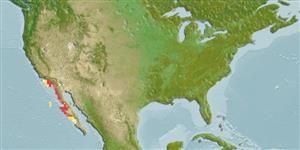Environment: milieu / climate zone / profondeur / distribution range
Écologie
marin; saumâtre pelagic-neritic; profondeur 0 - 50 m (Ref. 189). Subtropical; 34°N - 20°N, 120°W - 109°W (Ref. 189)
Eastern Central Pacific: Belmont Shores, Long Beach Harbor, California, USA south to Magdalena Bay on the Pacific coast of Baja California; not in Gulf of California.
Taille / Poids / Âge
Maturité: Lm ? range ? - ? cm
Max length : 12.0 cm TL mâle / non sexé; (Ref. 96339); common length : 7.0 cm SL mâle / non sexé; (Ref. 9298); âge max. reporté: 3.00 années (Ref. 72482)
Description synthétique
Clés d'identification | Morphologie | Morphométrie
Épines dorsales (Total) : 0; Épines anales: 0; Rayons mous anaux: 20 - 25. Body fairly elongate. Snout moderate, about 3/4 eye diameter; maxilla moderate, tip pointed, reaching onto inter-operculum, but not to edge of gill cover; gill cover canals of walkeri-type. Anal fin moderate, its origin usually somewhat before midpoint of dorsal fin base. A silver stripe along flank, about 3/4 eye diameter.
Body shape (shape guide): elongated; Cross section: oval.
Reportedly common in estuaries and backwaters of bays and occasionally near shores outside bays (Ref. 6792). The fifth most abundant fish taken by various gear in Newport Bay, California; a midwater schooling species caught in bag seine hauls mainly in July and September (Ref. 6361). Oviparous, with planktonic eggs and larvae (Ref. 35602).
Life cycle and mating behavior
Maturité | Reproduction | Frai | Œufs | Fécondité | Larves
Oviparous (Ref. 35602). Spawn in school (Ref. 205).
Whitehead, P.J.P., G.J. Nelson and T. Wongratana, 1988. FAO Species Catalogue. Vol. 7. Clupeoid fishes of the world (Suborder Clupeoidei). An annotated and illustrated catalogue of the herrings, sardines, pilchards, sprats, shads, anchovies and wolf-herrings. FAO Fish. Synop. 125(7/2):305-579. Rome: FAO. (Ref. 189)
Statut dans la liste rouge de l'IUCN (Ref. 130435: Version 2025-1)
Menace pour l'homme
Harmless
Utilisations par l'homme
Pêcheries: pêcheries vivrières
Outils
Articles particuliers
Télécharger en XML
Sources Internet
Estimates based on models
Preferred temperature (Réf.
123201): 17.4 - 18.1, mean 17.7 °C (based on 2 cells).
Phylogenetic diversity index (Réf.
82804): PD
50 = 0.5000 [Uniqueness, from 0.5 = low to 2.0 = high].
Bayesian length-weight: a=0.00513 (0.00234 - 0.01125), b=3.14 (2.97 - 3.31), in cm total length, based on LWR estimates for this Genus-body shape (Ref.
93245).
Niveau trophique (Réf.
69278): 3.4 ±0.4 se; based on size and trophs of closest relatives
Résilience (Réf.
120179): Haut, temps minimum de doublement de population inférieur à 15 mois (tmax=3).
Fishing Vulnerability (Ref.
59153): Low vulnerability (10 of 100).
🛈
